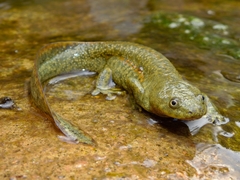Natterjack toad
Epidalea calamita
The Epidalea calamita, commonly known as the natterjack toad or sapo corredor in Spanish, is a distinct amphibian species found in the Comunidad Valenciana and various other parts of Europe. This toad is notable for its unique physical characteristics and adaptability to diverse environments.
- Appearance: The natterjack toad is relatively small compared to other toads, with adults measuring between 6 to 8 cm in length. It is easily recognizable by the distinctive yellow or greenish stripe running down its back, contrasted with its warty, olive or brownish skin.
- Habitat: This species is versatile in its choice of habitat, frequently occupying sandy dunes, heaths, and grasslands. It is well-adapted to dry environments and can often be found in open landscapes with sparse vegetation.
- Behavior: Known for its dotted running rather than hopping, the natterjack toad is active predominantly at night. During the breeding season, usually from March to June, males produce a loud, distinctive call to attract females, which can often be heard over long distances.
- Conservation: Although the species is not considered endangered, its habitat is sometimes threatened by human activities, which makes it important to monitor and preserve their environments.
The natterjack toad is a cherished native species of the Comunidad Valenciana, playing an essential role in local ecosystems. Conservation efforts are vital to ensure that this charming amphibian continues to thrive alongside other native fauna and flora.







